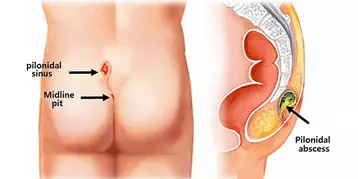
Dr. Rajendra Sonavane
M.S.,F.I.C.S.,F.I.A.G.E.S.,F.I.S.C.P.
Certified training in LASER surgery, Germany & Poland
What is Pilonidal Sinus?

Pilonidal Sinus is the formation of a tract between the cleft of the buttocks (natal cleft). This tract begins to collect debris of hair, dirt, etc.; gets infected and starts to fill with pus. This chronic skin infection can be very painful and it can impair one’s various bodily functions like sitting, riding a bike, etc.
What are the signs and symptoms of pilonidal sinus?
Symptoms may vary from mild to severe and may include any of the following:
- A small hole or an opening in the natal cleft, Pus or other discharge which could be clear, cloudy or bloody, foul-smelling fluids.
- If infected, the area can become red and tender
- Pain or swelling in and around the tailbone area
- Painful lump under the skin
- Difficulty in sitting, riding due to pain in that area
- Fever, sometimes
What causes pilonidal sinus?
- Thick body hair growth in that region, which is more common with males
- People who have a sedentary lifestyle and those who sit for long hours at a stretch
- Hormonal changes particularly during puberty
- Obesity
- Family history
- History of previous pilonidal sinus
How is pilonidal sinus diagnosed?
After noting the patient’s specific complaints, the doctor will do a physical examination of the local area near the tailbone where there is pain. This is sufficient to detect the pilonidal sinus. Sometimes, in a complicated case, an MRI scan may be suggested.
How do you treat Pilonidal Sinus?
Previously, pilonidal sinus was treated with Excision and Flap surgery. These surgeries had limitations of being invasive, and painful. The patient took a long time to heal.
Proctocare clinic has done pioneering work with remarkable results by offering LASER treatment for pilonidal sinus. This surgery is called LASER Pilonidoplasty (LPP). In this surgery, the tract is cleared of the accumulated debris with the help of an endoscope. Then the LASER energy is applied to the internal walls of the tract to seal it. In this day-care procedure, the recovery is faster and relatively painless. Hence, we recommend patients with pilonidal sinus to opt for this advance treatment.